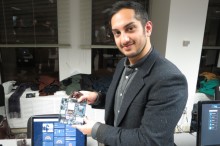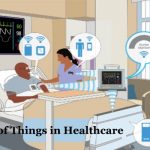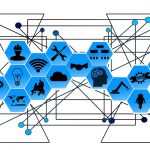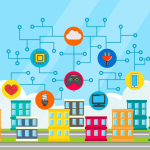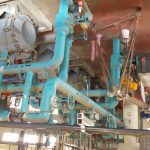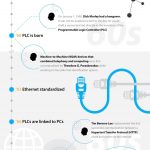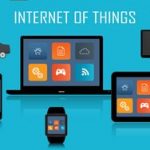Microbe monitors & Microchips on the NYC web of things truthful
<img title="Microbe Monitors & Microchips At the NYC Internet of Things Fair in the financial District on Monday, on the first-ever NYC web of things honest, a rating of corporations demoed ideas to bridge data, the cloud, and actual-world units. The technology on show ranged from a screen that retains tabs on the microbes that easy wastewater to a type of tiny LED that may be used to make power-efficient digital displays. The fair was hosted by IoT primary, which runs the NYC internet of issues Meetup staff. this type of gathering tends to crop up when a new tech du jour surfaces. The web of issues, the concept that of gathering information from and controlling devices which can be linked to the net, has seen its share of buzz. alternatively, common client demand to “connect all things” has now not took place—yet. for example, ultimately month’s Quirky press convention, normal electrical’s chief marketing officer Beth Comstock mentioned, “Most americans don’t suppose good dwelling know-how is reasonably priced.” So companies comparable to Quirky, which was once amongst remaining evening’s exhibitors, were trying to show that linking gadgets to the online, for consumer and different needs, can find an target market. 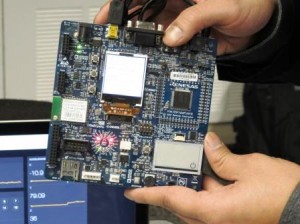 one of the applied sciences on display were precursors to units yet to come back. for example, bug Labs in ny confirmed how microchips on a circuit board with a temperature sensor, an accelerometer, and other components can “Dweet” knowledge to a linked dashboard. Dweet is device from malicious program Labs that lets gadgets share knowledge on the internet. Vishal Kumar, director of solutions engineering with computer virus Labs, mentioned the chip used to be aggregating sensor information along with a picture feed from a Dropcam, even if they use distinct infrastructure. “It’s mashing up two utterly different information sources into one dashboard,” he stated. different exhibitors included Ottomate from Washington, DC, which is growing hardware and an app to make more gadgets within the dwelling “good.” Ottomate (see slideshow above) is more or less a bypass plug-in that goes right into a wall socket. The tool to be controlled is then plugged into Ottomate, letting the consumer control sure features via a smartphone. CEO Shazia Sami said Ottomate works with televisions, coffeemakers, curling irons, and DVRs, robotically turning such devices on and off according to the habits realized from customers. there’s also an power financial savings function to the know-how. “we’ve got an algorithm that detects and forestalls the phantom electrical energy, which is always pulling,” Sami mentioned, regarding the standby energy that some units draw from the grid even when switched off. one of the vital expertise on show had industrial usage in thoughts. BluCarbon Analytics, a the big apple startup, presented its microbe detection and diagnostic device for wastewater remedy. Microbes take in the pollution of wastewater, use it as a meals stock to convert into their very own energy, said CEO Shane Eten. His firm’s software helps water utilities have in mind how smartly the microbes are performing in treatment plants, which is able to help make their operations extra efficient. BluCarbon’s collector mechanically takes samples from the reactors. a web app helps water utilities take into account the place the microbes are growing and the way lively and productive they’re. the implications can tell water utilities in the event that they want to aerate the treatment plants extra or take different measures. “they’re looking to create an atmosphere to flourish,” Eten mentioned. “we are helping them consider whether it is working it or no longer.” in the meantime, with an idea born a few years ago from the Columbia know-how Ventures tech switch program, Lumiode is growing digital displays similar to the digital indicators in times square—but on a small scale. Lumiode uses tiny, pixelated LEDs to be each the sunshine source and the image shown in electronic shows. in many consumer electronics, a single LED is used to backlight the screens of smartphones and laptops. Brian Tull, vice chairman of analysis and building with Lumiode, said the know-how could be helpful for developing tiny digital projectors, displays inside of helmets, and shows within automobiles. as soon as it has the tools, Lumiode desires to put together a prototype building equipment, Tull stated. that might help product makers better take into account how the technology may be used—and assist Lumiode get its product out into the world.
one of the applied sciences on display were precursors to units yet to come back. for example, bug Labs in ny confirmed how microchips on a circuit board with a temperature sensor, an accelerometer, and other components can “Dweet” knowledge to a linked dashboard. Dweet is device from malicious program Labs that lets gadgets share knowledge on the internet. Vishal Kumar, director of solutions engineering with computer virus Labs, mentioned the chip used to be aggregating sensor information along with a picture feed from a Dropcam, even if they use distinct infrastructure. “It’s mashing up two utterly different information sources into one dashboard,” he stated. different exhibitors included Ottomate from Washington, DC, which is growing hardware and an app to make more gadgets within the dwelling “good.” Ottomate (see slideshow above) is more or less a bypass plug-in that goes right into a wall socket. The tool to be controlled is then plugged into Ottomate, letting the consumer control sure features via a smartphone. CEO Shazia Sami said Ottomate works with televisions, coffeemakers, curling irons, and DVRs, robotically turning such devices on and off according to the habits realized from customers. there’s also an power financial savings function to the know-how. “we’ve got an algorithm that detects and forestalls the phantom electrical energy, which is always pulling,” Sami mentioned, regarding the standby energy that some units draw from the grid even when switched off. one of the vital expertise on show had industrial usage in thoughts. BluCarbon Analytics, a the big apple startup, presented its microbe detection and diagnostic device for wastewater remedy. Microbes take in the pollution of wastewater, use it as a meals stock to convert into their very own energy, said CEO Shane Eten. His firm’s software helps water utilities have in mind how smartly the microbes are performing in treatment plants, which is able to help make their operations extra efficient. BluCarbon’s collector mechanically takes samples from the reactors. a web app helps water utilities take into account the place the microbes are growing and the way lively and productive they’re. the implications can tell water utilities in the event that they want to aerate the treatment plants extra or take different measures. “they’re looking to create an atmosphere to flourish,” Eten mentioned. “we are helping them consider whether it is working it or no longer.” in the meantime, with an idea born a few years ago from the Columbia know-how Ventures tech switch program, Lumiode is growing digital displays similar to the digital indicators in times square—but on a small scale. Lumiode uses tiny, pixelated LEDs to be each the sunshine source and the image shown in electronic shows. in many consumer electronics, a single LED is used to backlight the screens of smartphones and laptops. Brian Tull, vice chairman of analysis and building with Lumiode, said the know-how could be helpful for developing tiny digital projectors, displays inside of helmets, and shows within automobiles. as soon as it has the tools, Lumiode desires to put together a prototype building equipment, Tull stated. that might help product makers better take into account how the technology may be used—and assist Lumiode get its product out into the world.
 one of the applied sciences on display were precursors to units yet to come back. for example, bug Labs in ny confirmed how microchips on a circuit board with a temperature sensor, an accelerometer, and other components can “Dweet” knowledge to a linked dashboard. Dweet is device from malicious program Labs that lets gadgets share knowledge on the internet. Vishal Kumar, director of solutions engineering with computer virus Labs, mentioned the chip used to be aggregating sensor information along with a picture feed from a Dropcam, even if they use distinct infrastructure. “It’s mashing up two utterly different information sources into one dashboard,” he stated. different exhibitors included Ottomate from Washington, DC, which is growing hardware and an app to make more gadgets within the dwelling “good.” Ottomate (see slideshow above) is more or less a bypass plug-in that goes right into a wall socket. The tool to be controlled is then plugged into Ottomate, letting the consumer control sure features via a smartphone. CEO Shazia Sami said Ottomate works with televisions, coffeemakers, curling irons, and DVRs, robotically turning such devices on and off according to the habits realized from customers. there’s also an power financial savings function to the know-how. “we’ve got an algorithm that detects and forestalls the phantom electrical energy, which is always pulling,” Sami mentioned, regarding the standby energy that some units draw from the grid even when switched off. one of the vital expertise on show had industrial usage in thoughts. BluCarbon Analytics, a the big apple startup, presented its microbe detection and diagnostic device for wastewater remedy. Microbes take in the pollution of wastewater, use it as a meals stock to convert into their very own energy, said CEO Shane Eten. His firm’s software helps water utilities have in mind how smartly the microbes are performing in treatment plants, which is able to help make their operations extra efficient. BluCarbon’s collector mechanically takes samples from the reactors. a web app helps water utilities take into account the place the microbes are growing and the way lively and productive they’re. the implications can tell water utilities in the event that they want to aerate the treatment plants extra or take different measures. “they’re looking to create an atmosphere to flourish,” Eten mentioned. “we are helping them consider whether it is working it or no longer.” in the meantime, with an idea born a few years ago from the Columbia know-how Ventures tech switch program, Lumiode is growing digital displays similar to the digital indicators in times square—but on a small scale. Lumiode uses tiny, pixelated LEDs to be each the sunshine source and the image shown in electronic shows. in many consumer electronics, a single LED is used to backlight the screens of smartphones and laptops. Brian Tull, vice chairman of analysis and building with Lumiode, said the know-how could be helpful for developing tiny digital projectors, displays inside of helmets, and shows within automobiles. as soon as it has the tools, Lumiode desires to put together a prototype building equipment, Tull stated. that might help product makers better take into account how the technology may be used—and assist Lumiode get its product out into the world.
one of the applied sciences on display were precursors to units yet to come back. for example, bug Labs in ny confirmed how microchips on a circuit board with a temperature sensor, an accelerometer, and other components can “Dweet” knowledge to a linked dashboard. Dweet is device from malicious program Labs that lets gadgets share knowledge on the internet. Vishal Kumar, director of solutions engineering with computer virus Labs, mentioned the chip used to be aggregating sensor information along with a picture feed from a Dropcam, even if they use distinct infrastructure. “It’s mashing up two utterly different information sources into one dashboard,” he stated. different exhibitors included Ottomate from Washington, DC, which is growing hardware and an app to make more gadgets within the dwelling “good.” Ottomate (see slideshow above) is more or less a bypass plug-in that goes right into a wall socket. The tool to be controlled is then plugged into Ottomate, letting the consumer control sure features via a smartphone. CEO Shazia Sami said Ottomate works with televisions, coffeemakers, curling irons, and DVRs, robotically turning such devices on and off according to the habits realized from customers. there’s also an power financial savings function to the know-how. “we’ve got an algorithm that detects and forestalls the phantom electrical energy, which is always pulling,” Sami mentioned, regarding the standby energy that some units draw from the grid even when switched off. one of the vital expertise on show had industrial usage in thoughts. BluCarbon Analytics, a the big apple startup, presented its microbe detection and diagnostic device for wastewater remedy. Microbes take in the pollution of wastewater, use it as a meals stock to convert into their very own energy, said CEO Shane Eten. His firm’s software helps water utilities have in mind how smartly the microbes are performing in treatment plants, which is able to help make their operations extra efficient. BluCarbon’s collector mechanically takes samples from the reactors. a web app helps water utilities take into account the place the microbes are growing and the way lively and productive they’re. the implications can tell water utilities in the event that they want to aerate the treatment plants extra or take different measures. “they’re looking to create an atmosphere to flourish,” Eten mentioned. “we are helping them consider whether it is working it or no longer.” in the meantime, with an idea born a few years ago from the Columbia know-how Ventures tech switch program, Lumiode is growing digital displays similar to the digital indicators in times square—but on a small scale. Lumiode uses tiny, pixelated LEDs to be each the sunshine source and the image shown in electronic shows. in many consumer electronics, a single LED is used to backlight the screens of smartphones and laptops. Brian Tull, vice chairman of analysis and building with Lumiode, said the know-how could be helpful for developing tiny digital projectors, displays inside of helmets, and shows within automobiles. as soon as it has the tools, Lumiode desires to put together a prototype building equipment, Tull stated. that might help product makers better take into account how the technology may be used—and assist Lumiode get its product out into the world.
(139)

